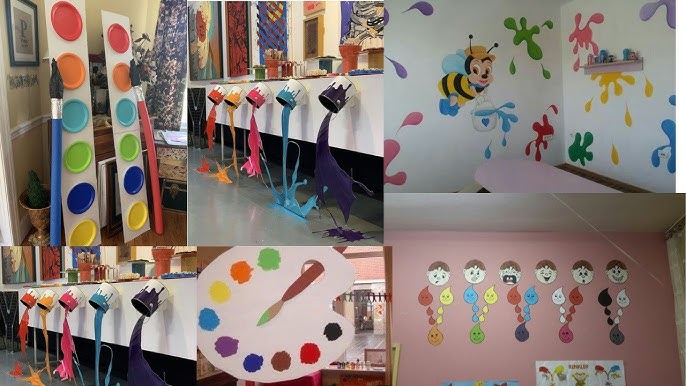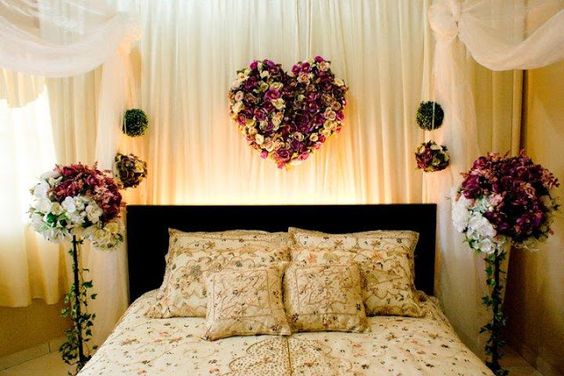20 Inspiring Art Room Decoration Ideas to Boost Creativity

When it comes to setting up an art room, the atmosphere can significantly influence creativity and productivity. A well-decorated space not only makes you feel inspired but also provides a functional environment for your artistic endeavors. Whether you’re an artist, a hobbyist, or a teacher, the right art room decoration ideas can transform your creative space into a vibrant, motivating area. In this article, we’ll explore some amazing art room decoration ideas to help you create a place where inspiration flows effortlessly.
1. Bright and Bold Color Palettes
One of the simplest ways to enhance the look of your art room is by using bold, lively colors. Choose hues that spark creativity, like vibrant oranges, energizing yellows, or calming blues. The right colors can make a significant impact on your mood and creativity. You can also paint one wall with a chalkboard or whiteboard paint to create a space for quick sketches and brainstorming.
Pro Tip: Use lighter shades for the main walls and opt for accent walls in bright, bold colors to add a pop of energy.
2. Incorporate Art Displays
What better way to decorate an art room than by showcasing your own work? Create a feature wall where you can display paintings, drawings, and sculptures. Frame your art in stylish frames that match the theme of the room, or go for a more rustic look with hanging wire and clips for a gallery-style display.
This not only personalizes the space but also serves as a source of constant inspiration.
3. Functional Storage Solutions
An art room needs to be functional as well as aesthetically pleasing. To keep your supplies organized, use smart storage solutions like open shelves, pegboards, and rolling carts. These not only make your materials accessible but also contribute to the room’s design.
You can label bins and baskets with fun tags for a more playful look. A clutter-free space helps you stay focused and productive.
4. Incorporate Natural Light
Natural light is crucial in an art room. It enhances the colors you’re working with and promotes a healthy atmosphere. If possible, position your art desk near a window or even create an art nook that captures as much sunlight as possible. Consider using sheer curtains or blinds to control the light intensity while maintaining a bright environment.
Pro Tip: If natural light is limited, invest in good quality artificial lighting that mimics daylight, like LED bulbs or task lamps with adjustable brightness.
5. Add Inspirational Quotes
Words can have a profound impact on your mindset. Including inspiring quotes from famous artists or personal mottos can motivate and uplift you. Hang these quotes on the walls or add them to your workspace with decorative typography prints. This can help you stay focused and remind you why you love creating art.
6. Greenery for Freshness
Incorporating plants into your art room decoration ideas is a fantastic way to bring life to the space. Greenery adds a calming, refreshing vibe that complements the creative process. Consider adding low-maintenance indoor plants like succulents, ferns, or even hanging planters for a boho-inspired look.
Not only do plants beautify the space, but they also purify the air, contributing to a healthier environment.
7. Create a Feature Wall for Supplies
Having a designated area to display your supplies is both practical and stylish. Organize your art materials in an open, creative way on a feature wall. You can use a large corkboard, floating shelves, or a colorful pegboard to store brushes, paint tubes, and other tools. This turns your materials into part of the room’s decor while keeping them accessible.
8. Incorporate Artful Furniture
Don’t overlook the furniture in your art room. Choose items that are not only functional but also add character. For instance, a vintage wooden desk can bring a sense of nostalgia, while a modern minimalist chair can provide comfort and a clean look. Opt for multi-functional furniture such as storage benches or tables with built-in drawers to maximize space.
Consider adding an ergonomic chair for long hours of work or a comfy lounge chair where you can relax and get inspired.
9. Use Art-Themed Wallpaper or Murals
Transform one of your walls into an eye-catching masterpiece with art-themed wallpaper or murals. This could be anything from abstract designs to nature-inspired prints. If you prefer a more DIY approach, you can create your own mural or pattern using stencils or masking tape. The wall can serve as a backdrop to your art-making process or even as a finished piece.
10. Create a Crafting Corner
If you’re into multiple forms of art, having a dedicated crafting corner is a great way to organize your supplies for different projects. Create a cozy nook with ample storage and surfaces for scrapbooking, knitting, or any other art forms you love. You can even add a bulletin board to pin ideas or inspiration images.
11. Incorporate Artistic Textiles
Textiles are often overlooked in art room decoration ideas, but they can make a huge difference in adding comfort and style. Consider hanging fabric art on the walls, such as tapestries or woven wall hangings, to bring in texture and color. You can also use comfortable cushions or throws on chairs to make the space cozy for longer art sessions.
12. Vintage Touches for Personality
Add some vintage or antique pieces to your art room for a unique touch. This could include old easels, retro picture frames, or classic art tools. The mix of old and new not only gives the room personality but also adds a sense of history to your creative space.
13. Repurpose Old Art Supplies
Why not transform old or unused art supplies into decor? For example, you can turn a paintbrush collection into a beautiful sculpture, use empty paint cans as planters, or turn old canvases into wall art by reusing them for new projects. Repurposing materials this way keeps your space eco-friendly and gives you a chance to be creative in every aspect of your room.
14. Incorporate a Mirror for Reflection
A large mirror can serve both a practical and decorative purpose in your art room. Not only does it reflect light and make the space appear larger, but it also gives you a chance to step back and see your work from a different perspective. Choose a mirror with a stylish frame that complements your overall room design.
15. Personalize with Your Favorite Art Styles
Every artist has a unique style. Whether you love realism, abstract, or minimalist art, incorporating elements of your favorite art forms into the room can make it feel more personal. This could mean decorating with artwork that reflects your style or choosing colors and patterns that resonate with your creative process.
16. Have a Statement Piece
Adding one statement piece, such as a large-scale painting or an artistic sculpture, can serve as the focal point of the room. This will draw attention and set the tone for the space. A dramatic piece that aligns with your art style can create a beautiful conversation starter while inspiring you to create.
17. Hang Artistic Lighting Fixtures
Lighting can completely transform the ambiance of your art room. Choose artistic lighting fixtures that complement the room’s decor, such as vintage-style lamps, pendant lights, or even string lights. These can serve as functional pieces of art themselves while providing the illumination you need for working on your projects.
18. Create a Multi-Use Workspace
If you need to work on multiple projects at once, consider creating a multi-use workspace. Divide the room into different sections for drawing, painting, and other creative activities. Use room dividers, curtains, or different colored rugs to define each area while maintaining an open, airy feel.
19. Add a Pop of Metallic Accents
Metallic accents such as gold, silver, or copper can add a touch of luxury to your art room. Consider incorporating metallic elements through picture frames, light fixtures, or even accent furniture. These shiny touches add a sophisticated edge to the overall space.
20. Maintain Flexibility for Creativity
The final tip for decorating your art room is to keep the space flexible. Art rooms need to evolve with your projects and creative ideas. Use furniture that’s easy to move or change out decor as your style and needs change. Whether it’s rotating artwork, swapping out furniture, or introducing new storage solutions, flexibility ensures that your space always inspires creativity.
Why Decorating an Art Room is Important
- Stimulates Creativity: A well-decorated art room serves as a visual catalyst for creativity. Colors, textures, and inspiring displays can trigger new ideas and encourage artistic exploration.
- Enhances Focus and Productivity: An organized and aesthetically pleasing space minimizes distractions and promotes a focused mindset, allowing artists to delve deeper into their work.
- Reflects Personal Style: Decorating an art room allows artists to express their unique style and personality, creating a space that feels personal and inspiring.
- Creates a Sense of Sanctuary: An art room should be a place where artists feel comfortable and at ease. Proper decoration helps transform it into a sanctuary where they can escape and immerse themselves in their creative process.
- Professional Presentation: For professional artists or teachers, a well-decorated art room creates a positive impression on clients, students, or visitors, showcasing their dedication and professionalism.
- Emotional well-being: A beautiful and inspiring art room can increase happiness and reduce stress.
Benefits of Decoration in an Art Room
- Increased Inspiration: Visual stimuli from artwork, colors, and inspirational quotes can spark new ideas and motivate artists to create.
- Improved Organization: Functional storage solutions and organized displays help artists easily access their supplies, saving time and reducing frustration.
- Enhanced Mood: Colors and textures can significantly impact mood. A well-decorated art room can create a positive and uplifting atmosphere.
- Greater Comfort: Comfortable furniture, adequate lighting, and a pleasant environment contribute to a more enjoyable and productive art-making experience.
- Boosted Confidence: Displaying personal artwork and creating a beautiful space can boost an artist’s confidence and sense of accomplishment.
- Better workflow: when the room is well organized, and decorated, the workflow is better, and the artist can focus on the art itself, and not on the searching for material.
- Community and Collaboration: In shared art spaces, thoughtful decoration can foster a sense of community and encourage collaboration among artists.
Recommendation
Room Decoration for Girls: Ideas, Inspiration, and Tips
Bride Room Decoration: Transforming Your Wedding Day with the Perfect Bridal Suite
Window Decoration Ideas for Living Room
Hotel Decoration Ideas: Transform Your Space with Stylish and Inviting Designs
Transform Your Room with Stunning Light Decorations: A Complete Guide for 2025
The Ultimate Guide to Dining Room Wall Decoration
Living Room Indoor Plants Decoration Ideas
Birthday Room Decoration Ideas: How to Create the Perfect Celebration Atmosphere
Simple Romantic Room Decoration Ideas
Conclusion
Decorating an art room is all about creating a space that fosters inspiration, creativity, and productivity. With the right combination of colors, furniture, storage, and personal touches, you can design an environment that’s perfect for your artistic practice. From showcasing your artwork to adding plants and incorporating creative storage, these art room decoration ideas will help you create the perfect sanctuary for your creativity.
Remember, the best art rooms reflect your personal style and artistic spirit. Keep experimenting and have fun with the process.
FAQs
Q: How to organize an art room?
A: Keep your art room tidy by organizing supplies with shelves, bins, and pegboards. Store frequently used items within easy reach and keep rarely used materials neatly arranged. A dedicated workspace boosts focus, while good lighting enhances creativity. An inspiration board or crafting corner adds a creative touch, making the space both functional and inspiring.
Q: How do I design my art room?
A: Design your art room with inspiring colors, a sturdy workspace, and good lighting. Keep supplies organized with shelves and labeled bins. Add an inspiration board, display finished artwork, and include ergonomic furniture for comfort. Personal touches like plants and artistic décor make the space inviting and creative.
Q: How big is an art room?
A: The space needed for an art room depends on the type of work being done. For painting and drawing, a 1000-square-foot room is enough for around 30 students, though a bigger space is always better. If the room also requires extra storage and a larger work area for materials, then about 1250 square feet would be ideal for better organization and comfort.






